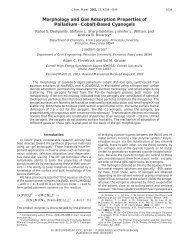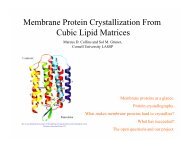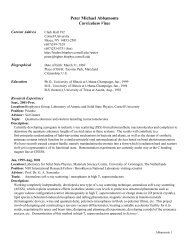Structural and Thermodynamic Characterization of T4 Lysozyme ...
Structural and Thermodynamic Characterization of T4 Lysozyme ...
Structural and Thermodynamic Characterization of T4 Lysozyme ...
You also want an ePaper? Increase the reach of your titles
YUMPU automatically turns print PDFs into web optimized ePapers that Google loves.
10,000 r<strong>and</strong>om coil conformations with an average R g <strong>of</strong> 38.0 Å, <strong>and</strong> the second contained 10,000unfolded conformations with residual structure with an average R g <strong>of</strong> 29.7 Å. The ensemble selectedfrom the pool with residual structure had an average R g <strong>of</strong> 31.2 Å, in agreement with Guinier analysis,<strong>and</strong> better described our experimental data than the selected r<strong>and</strong>om coil ensemble, which had anaverage R g <strong>of</strong> 36.1 Å (Figure 5 (b)).<strong>Structural</strong> Information from Fluorescence Quenching MeasurementsAdditional information on global conformational changes was derived from fluorescence quenchingmeasurements. <strong>T4</strong> lysozyme has five methionine residues in close proximity to the three tryptophanresidues present in the C-terminal lobe. The sulfur atom in methionine quenches tryptophan emission<strong>and</strong> provides a probe <strong>of</strong> the methionine-tryptophan separation. Denaturation <strong>of</strong> <strong>T4</strong> lysozyme is usuallyaccompanied by an increase in emission intensity (44), consistent with an increased methioninetryptoph<strong>and</strong>istance. In the seleno-methionine variant <strong>of</strong> L99A (Se-Met L99A), the methionines arereplaced with seleno-methionines. As selenium <strong>and</strong> sulfur have differing quenching strengths acomparison <strong>of</strong> L99A <strong>and</strong> Se-Met L99A yields additional information on the spatial compactness <strong>of</strong> theunfolded state <strong>of</strong> L99A (45).Tryptophan fluorescence measurements were made on Se-Met L99A in pH 3.0, 50 mM glycine,20 mM NaCl <strong>and</strong> pH 7.0, 50 mM tris, 20 mM NaCl buffers <strong>and</strong> compared to those <strong>of</strong> L99A under thesame conditions. The intensity increase accompanying denaturation was more pronounced for Se-MetL99A than for L99A, consistent with the stronger quenching ability <strong>of</strong> selenium (Figure 6). Figure 7 (a)shows that at each pressure, the centers <strong>of</strong> spectral mass were similar for L99A <strong>and</strong> Se-Met L99A in thesame solvent, indicating that these two mutants are structurally similar at any given pressure <strong>and</strong> that theintroduction <strong>of</strong> seleno-methionines does not significantly distort the shape <strong>of</strong> the fluorescence spectra orchange the denaturation behavior.16









